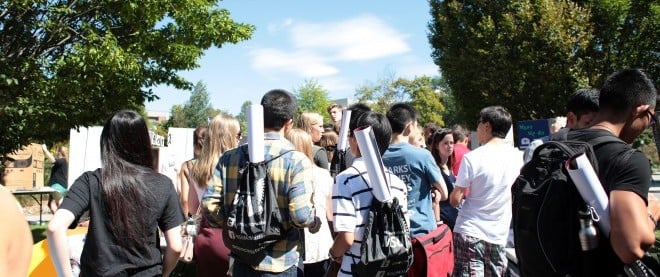How international students feel about Canada
Results from a new survey suggest Canada is well-positioned for the talent war
Hamilton, ON (04/09/13) – McMaster University students enjoy what was their last day before classes start. Students attend this year’s Clubfest, an opportunity that allows students to learn about the different clubs on campus.
Share

In 1916, Bill Boeing went to MIT to hire his first chief engineer. He picked Wong Tsoo, a Chinese guy who had emigrated to England at the age of 16 for undergrad before crossing the Atlantic for graduate school. Wong quickly got to work on Boeing’s first commercially successful plane, the C-Model. Imagine how different the airline industry might have been had another country’s university—Canada’s perhaps—enticed Wong. Both Canada and the U.S. had racist anti-Chinese policies at the time, such as the Head Tax, but if Canada had been less racist than America, might the Wongs of the era have chosen McGill?
We’ve come a long way since then. From 2001 to 2008, the number of international students in Canada increased at a rate of 4.3% per year; between 2008 to 2012 the annual increase was, astonishingly, 12.3%. There were 265,377 in 2012 (74% of them in post-secondary schools). We now get five per cent of all international students worldwide, making Canada the seventh most popular destination after the US, UK, China, France, Germany and Australia, according to Project Atlas.
Not all of these people are future chief engineers but many will become well-adjusted citizens and unofficial ambassadors. Not only do Canadian students benefit (for the most part, it seems) from more diverse classes, our economy is lifted by the estimated $7.7 billion they spend each year.
But what if that suddenly changed? At a recent Conference Board of Canada meeting on the future of skills and education, an audience member chided post-secondary officials for relying so much on tuition from international students, in particular the Chinese, who accounted for one-third of the 2012 total.
He has a reason to worry. In Australia, a country with even more foreign students than Canada, a string of assaults and thefts from Indian students in 2009 led to protests down under and an uproar in the Indian press. An Indian government investigation concluded 23 of 152 attacks were racially motivated. After that, there was a sharp decline in the number of Indian students heading to Australia.
The lesson is that it’s important to treat international students well. The Canadian Bureau for International Education, a research and advocacy group, is one of the few organizations to actually ask them how they’re doing. They surveyed 1,509 international students from 25 universities and colleges and printed results in their annual members’ report, shared with Maclean’s on Tuesday.
The findings are mostly encouraging. When asked why they came to Canada, 77% of international students agreed that Canada being “tolerant and not discriminatory” was either very important or essential to their choice and 82% agreed it was, in fact, tolerant and welcoming once they got here.
What’s more, 76% agreed Canadians are “friendly when you get to know them.”
Most impressive is that 91% of students agreed they were either satisfied or very satisfied with studying in Canada and 96% would definitely or probably recommend Canada as a place to study.
The report also took a closer look at discrimination with survey questions and interviews. On the survey, racial discrimination from professors was reported by 15% of students, from institutional staff by 17%, from other students by 23% and in the broader community by 25%. Cultural or religious discrimination from professors was reported by 13% of students, from institutional staff by 15%, from other students by 21% and the broader community by 21%.
That seems high although it’s clear at least some of the things students considered discriminatory may not have been, depending on the student’s definition. One complained about international students paying more for tuition. One cited “a consistently rude staff member at the International Student Centre.” One said the curriculum was too “Canadian culture-oriented.” Another “sensed” discrimination.
While one case of discrimination is too many, there were only a couple of concrete examples in the report, including a staff member and professor who, “assumed that the student was Catholic, based on his country of origin, and made assumptions about his working-style based on religious and cultural stereotypes,” and a student who experienced racial slurs emanating “mostly from drunk people in bars.”
There are also relatively few cases recent reports in the media. A McGill University professor last year told an Egyptian student he wanted his “death.” Students barged into a class earlier this month to protest the “racist professor.” A Senate committee concluded his behaviour constituted harassment but not discrimination. The other was recent hate crime off campus against Muslim Queen’s University students.
But compare all this to a 2012 survey of more than 6,200 international students in Europe by SVR Research Unit. Discrimination—including violence—was reported by 40% of international students in France, 39% in Germany, 35% in Sweden, 30% in the Netherlands and 27% in the UK.
Taken together it suggests we’re doing a decent job welcoming international students compared to other countries. There’s obviously work left to do but, for now, we’re well positioned for the global talent war.